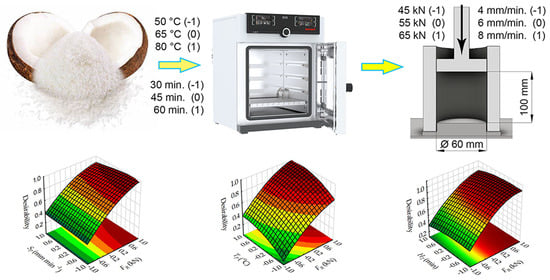Application of the Surface Regression Technique for Enhancing the Input Factors and Responses for Processing Coconut Oil under Vertical Compression
Abstract
1. Introduction
2. Materials and Methods
2.1. Sample and Experimental Conditions
2.2. Determination of Sample Moisture Content
2.3. Determination of the Oil Content of the Sample
2.4. Box–Behnken Experimental Design
2.5. Samples Pretreatment
2.6. Compression Tests
2.7. Oil Yield
2.8. Oil Expression Efficiency
2.9. Deformation Energy
2.10. Samples Hardness
2.11. Statistical Analysis of Experimental Data
3. Results and Discussion
3.1. Observed Responses
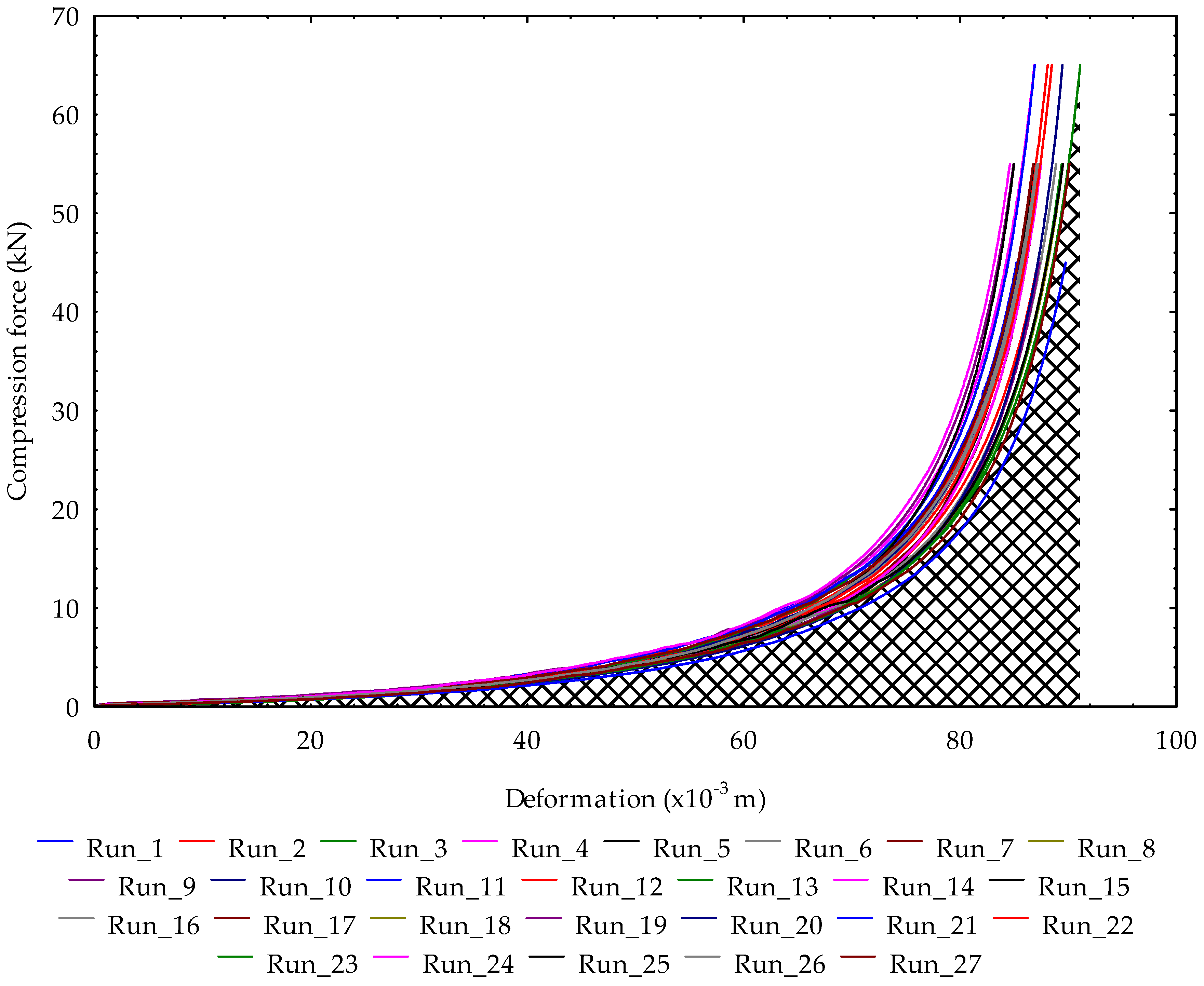
3.2. ANOVA Analysis and Established Regression Models for OY, OEE, and EN
3.3. Determined Optimal Factors’ Combination for the Responses
3.4. Validation of the Regression Models
3.5. Established Findings in Relation to Other Studies
4. Conclusions
Author Contributions
Funding
Institutional Review Board Statement
Informed Consent Statement
Data Availability Statement
Conflicts of Interest
References
- Chan, E.; Elevitch, C.R. Species Profiles for Pacific Island Agroforestry. 2006. Available online: www.traditionaltree.org (accessed on 26 March 2024).
- Mohammed, N.K.; Samir, Z.T.; Jassim, M.A.; Saeed, S.K. Effect of different extraction methods on physicochemical properties, antioxidant activity, of virgin coconut oil. Mater. Today Proc. 2021, 42, 2000–2005. [Google Scholar] [CrossRef]
- DebMandal, M.; Mandal, S. Coconut (Cocos nucifera L.: Arecaceae): In health promotion and disease prevention. Asian Pacific J. Trop. Med. 2011, 4, 241–247. [Google Scholar] [CrossRef]
- NMCE. Report on Copra; National Multi-commodity Exchange of India Limited: Mumbai, India, 2007; pp. 1–14. [Google Scholar]
- Sandupama, P.; Munasinghe, D.; Jayasinghe, M. Coconut oil as a therapeutic treatment for alzheimer’s disease: A review. J. Future Foods. 2022, 2, 41–52. [Google Scholar] [CrossRef]
- Dean, C. Coconut oil for Alzheimer’s. J. Am. Acad. Physician Assist. 2012, 25, 1–5. [Google Scholar]
- Guttmann, R.; Sims, P.L.; Churchill, C.R.; Waters, C.R.; Berry, B.M.; Wells, J.J. Coconut oil and its constituents as a treatment for alzheimer’s dementia. J. Student Res. 2020, 9, 1–6. [Google Scholar] [CrossRef]
- Abd Rashid, S.N.A.; Misson, M.; Yaakob, H.; Latiff, N.A.; Sarmidi, M.R. Addition of virgin coconut oil: Influence on the nutritional value and consumer acceptance of dark chocolate. Trans. Sci. Technol. 2017, 4, 426–431. [Google Scholar]
- Boateng, L.; Ansong, R.; Owusu, W.B.; Steiner-Asiedu, M. Coconut oil and palm oil’s role in nutrition, health and national development: A revew. Ghana. Med. J. 2016, 50, 189–196. [Google Scholar] [CrossRef]
- Pham, L.J. Coconut (Cocos nucifera). In Industrial Oil Crops; AOCS Press: Urbana, IL, USA, 2016; pp. 231–242. [Google Scholar]
- Mikolajczak, N. Coconut oil in human diet-nutrition value and potential health benefits. J. Educ. Health Sport 2017, 7, 307–319. [Google Scholar]
- Adeeko, K.A.; Ajibola, O.O. Processing factors affecting yield and quality of mechanically expressed groundnut oil. J. Agric. Eng. Res. 1990, 45, 31–43. [Google Scholar] [CrossRef]
- Karaj, S.; Muller, J. Optimizing mechanical oil extraction of Jatropha curcas L. seeds with respect to press capacity, oil recovery and energy efficiency. Ind. Crops Prod. 2011, 34, 1010–1016. [Google Scholar] [CrossRef]
- Tunde-Akintunde, T.Y.; Akintunde, B.O.; Igbeka, J.C. Effects of processing factors on yield and quality of mechanically expressed soybean oil. J. Eng. Technol. 2010, 9, 39–45. [Google Scholar]
- Olajide, J.O.; Igbeka, J.C.; Afolabi, T.J.; Emiola, O.A. Prediction of oil yield from groundnut kernels in an hydraulic press using artificial neural network (ANN). J. Food Eng. 2007, 81, 643–646. [Google Scholar] [CrossRef]
- Willems, P.; Kuipers, N.J.M.; De Haan, A.B. Hydraulic pressing of oilseeds: Experimental determination and modeling of yield and pressing rates. J. Food Eng. 2008, 89, 8–16. [Google Scholar] [CrossRef]
- Fakayode, O.A.; Ajav, E.A. Process optimization of mechanical oil extraction from Moringa (Moringa oleifera) seeds. Ind. Crops Prod. 2016, 90, 142–151. [Google Scholar] [CrossRef]
- Huang, S.; Hu, Y.; Li, F.; Jin, W.; Godara, V.; Wu, B. Optimization of mechanical oil extraction process from Camellia oleifera seeds regarding oil yield and energy consumption. J. Food Process Eng. 2019, 42, e13157. [Google Scholar] [CrossRef]
- Ogunsina, B.S.; Olatunde, G.A.; Adeleye, O. Effect of pretreatments on mechanical oil expression from Dika kernels. Niger. Food J. 2014, 32, 1–9. [Google Scholar] [CrossRef][Green Version]
- Romuli, S.; Karaj, S.; Latif, S.; Muller, J. Performance of mechanical co-extraction of Jatropha curcas L. kernels with rapeseed, maize or soybean with regard to oil recovery, press capacity and product quality. Ind. Crops Prod. 2017, 104, 81–90. [Google Scholar] [CrossRef]
- Subroto, E.; Manurung, R.; Heeres, H.J.; Broekhuis, A.A. Mechanical extraction of oil from Jatropha curcas L. kernel: Effect of processing parameters. Ind. Crops Prod. 2015, 63, 303–310. [Google Scholar] [CrossRef]
- Bogaert, L.; Mathieu, H.; Mhemdi, H.; Vorobiev, E. Characterization of oilseeds mechanical expression in an instrumented pilot screw press. Ind. Crops Prod. 2018, 121, 106–113. [Google Scholar] [CrossRef]
- Savoire, R.; Lanoiselle, J.L.; Vorobiev, E. Mechanical continuous oil expression from oilseeds. A review. Food Bioprocess. Technol. 2013, 6, 1–6. [Google Scholar] [CrossRef]
- Uitterhaegen, E.; Evon, P. Twin-screw extrusion technology for vegetable oil extrusion: A review. J. Food Eng. 2017, 212, 190–200. [Google Scholar] [CrossRef]
- Kandar, M.I.; Akil, H.M. Application of design of experiment (DoE) for parameters optimization in compression moulding for flax reinforced biocomposites. Procedia Chem. 2016, 19, 433–440. [Google Scholar] [CrossRef]
- Leticia, A.; Pighinelli, M.T.; Gambetta, R. Oil Presses. In Oilseeds; IntechOpen Limited: London, UK, 2012; Volume 2, pp. 33–52. [Google Scholar]
- Yang, G.R.; Wang, X.-J. Artificial Neural Networks for Neurocientists: A Primer. Neuron 2020, 107, 1048–1070. [Google Scholar] [CrossRef]
- Gupta, R.K.; Singh, R.C. Optimizing high-speed rotating shaft vibration control: Experimental investigation of squeeze film dampers and a comparative analysis using Artificial Neural Networks (ANN) and Response Surface Methodology (RSM). Expert Syst. Appl. 2024, 249, 1–24. [Google Scholar] [CrossRef]
- Duranoglu, D.; Altin, E.S.; Kucuk, I. Optimization of adaptive neuro-fuzzy inference system (ANFIS) parameters via Box-Behnken experimental design approach: The prediction of chromium adsorption. Heliyon 2024, 10, e25813. [Google Scholar] [CrossRef]
- Farzaneh, V.; Bakhshabadi, H.; Gharekhani, M.; Ganje, M.; Farzaneh, F.; Rashidzadeh, S.; Carvalho, I.S. Application of an adaptive neuro_fuzzy inference system (ANFIS) in the modeling of rapeseeds’ oil extraction. J. Food Eng. 2017, 40, e12562. [Google Scholar] [CrossRef]
- Jalili, F.; Jafari, S.M.; Emam-Djomeh, Z.; Malekjani, N. Optimization of ultrasound-assisted extraction of oil from canola seeds with the use of response surface methodology. Food. Anal. Methods 2018, 11, 598–612. [Google Scholar] [CrossRef]
- Dziwinki, P.; Bartczuk, L. A new hybrid particle swarm optimization and genetic algorithm method controlled by fuzzy logic. IEEE Trans. Fuzzy Syst. 2019, 28, 1140–1154. [Google Scholar] [CrossRef]
- Rathnayake, N.; Dang, T.L.; Hoshino, Y. A novel optimization algorithm: Cascaded Adaptive Neuro-Fuzzy Inference System. Int. J. Fuzzy Syst. 2021, 23, 1955–1971. [Google Scholar] [CrossRef]
- Chanioti, S.; Constantina, T. Optimization of ultrasound-assisted extraction of oil from olive pomace using response surface technology: Oil recovery, unsaponifiable matter, total phenol content and antioxidant activity. LWT—Food Sci. Technol. 2017, 79, 178–189. [Google Scholar] [CrossRef]
- Mourabet, M.; Rhilassi, A.E.; Boujaady, H.E.; Bennani-Ziatni, M.; Taitai, A. Use of response surface methodology for optimization of fluoride adsorption in an aqueous solution by brushite. Arab. J. Chem. 2017, 10, S3292–S3302. [Google Scholar] [CrossRef]
- Almasi, S.; Ghobadian, B.; Najafi, G.H.; Yusaf, T.; Soufi, M.D.; Hoseini, S.S. Optimization of an ultrasound-assisted biodiesel production process from one genotype of rapeseed (TERI (OE) R-983) as a novel feedback using response surface methodology. Energies 2019, 12, 2656. [Google Scholar] [CrossRef]
- Ayetigbo, O.; Latif, S.; Abass, A.; Muller, J. Preparation, optimization and characterization of foam from white-flesh and yellow-flesh cassava (Manihot esculenta) for powder production. Food Hydrocoll. 2019, 97, 105205. [Google Scholar] [CrossRef]
- Kok, S.L.; Lee, W.J.; Smith, R.L., Jr.; Suleiman, N.; Jom, K.N.; Vangnai, K.; Sharaai, A.H.B.; Chong, G.H. Role of virgin coconut oil (VCO) as co-extractant for obtaining xanthones from mangosteen (Garcinia mangostana) pericarp with supercritical carbon dioxide extraction. J. Supercrit. Fluids. 2021, 176, 105305. [Google Scholar] [CrossRef]
- IS:3579; Indian Standard Methods for Analysis of Oilseeds. Indian Standard Institute: New Delhi, India, 1996.
- Blahovec, J. Agromaterials Study Guide; Czech University of Life Sciences Prague: Prague, Czech Republic, 2008. [Google Scholar]
- Mohammadpour, H.; Sadrameli, S.M.; Eslami, F.; Asoodeh, A. Optimization of ultrasound-assisted extraction of Moringa peregrina oil with response surface methodology and comparison with Soxhlet method. Ind. Crops Prod. 2019, 131, 106–116. [Google Scholar] [CrossRef]
- Gurkan, A.K.G.; Kabutey, A.; Selvi, K.C.; Hrabe, P.; Herak, D.; Frankova, A. Investigation of heating and freezing pretreatments of mechanical, chemical and spectral properties of bulk sunflower seeds and oil. Processes 2020, 8, 411. [Google Scholar] [CrossRef]
- Ocholi, O.; Menkiti, M.; Auta, M.; Ezemagu, I. Optimization of the operating parameters for the extractive synthesis of biolubricant from sesame seed oil via response surface methodology. Egypt. J. Pet. 2018, 27, 265–275. [Google Scholar] [CrossRef]
- Deli, S.; Farah Masturah, M.; Tajul Aris, Y.; Wan Nadiah, W.A. The effects of physical parameters of the screw press oil expeller on oil yield from Nigella sativa L. seeds. Int. Food Res. J. 2011, 18, 1367–1373. [Google Scholar]
- Hernandez-Santos, B.; Rodriguez-Miranda, J.; Herman-Lara, E.; Torruco-Uco, J.G.; Carmona-Garcia, R.; Juarez-Barrientos, J.M.; Chavez-Zamudio, R.; Martinez-Sanchez, C.E. Effect of oil extraction assisted by ultrasound on the physicochemical properties and fatty acid profile of pumpkin seed oil (Cucurbita pepo). Ultrason. Sonochem. 2016, 31, 429–436. [Google Scholar] [CrossRef]
- Lysiak, G. Fracture toughness of pea: Weibull analysis. J. Food Eng. 2007, 83, 436–443. [Google Scholar] [CrossRef]
- Chakespari, A.G.; Rajabipour, A.; Mobli, H. Strength behaviour study of apples (cv. Shafi Abadi & Golab Kohanz) under compression loading. Mod. Appl. Sci. 2010, 4, 173–182. [Google Scholar]
- Herak, D.; Kabutey, A.; Sedlacek, A.; Gurdil, G. Mechanical behaviour of several layers of selected plant seeds under compression loading. Res. Agric. Eng. 2012, 58, 24–29. [Google Scholar] [CrossRef]
- Divisova, M.; Herak, D.; Kabutey, A.; Sigalingging, R.; Svatonova, T. Deformation curve characteristics of rapeseeds and sunflower seeds under compression loading. Sci. Agric. Bohem. 2014, 45, 180–186. [Google Scholar]
- Statsoft Inc. STATISTICA for Windows; Statsoft Inc.: Tulsa, OK, USA, 2013. [Google Scholar]
- Beerens, P. Screw-pressing of Jatropha seeds for fueling purposes in less developed countries. MSc Thesis, Eindhoven University of Technology, Eindhoven, The Netherlands, 2007. [Google Scholar]
- Willems, P.; Kuipers, N.J.M.; de Haan, A.B. A consolidation based extruder model to explore GAME process configurations. J. Food Eng. 2009, 90, 238–245. [Google Scholar] [CrossRef]
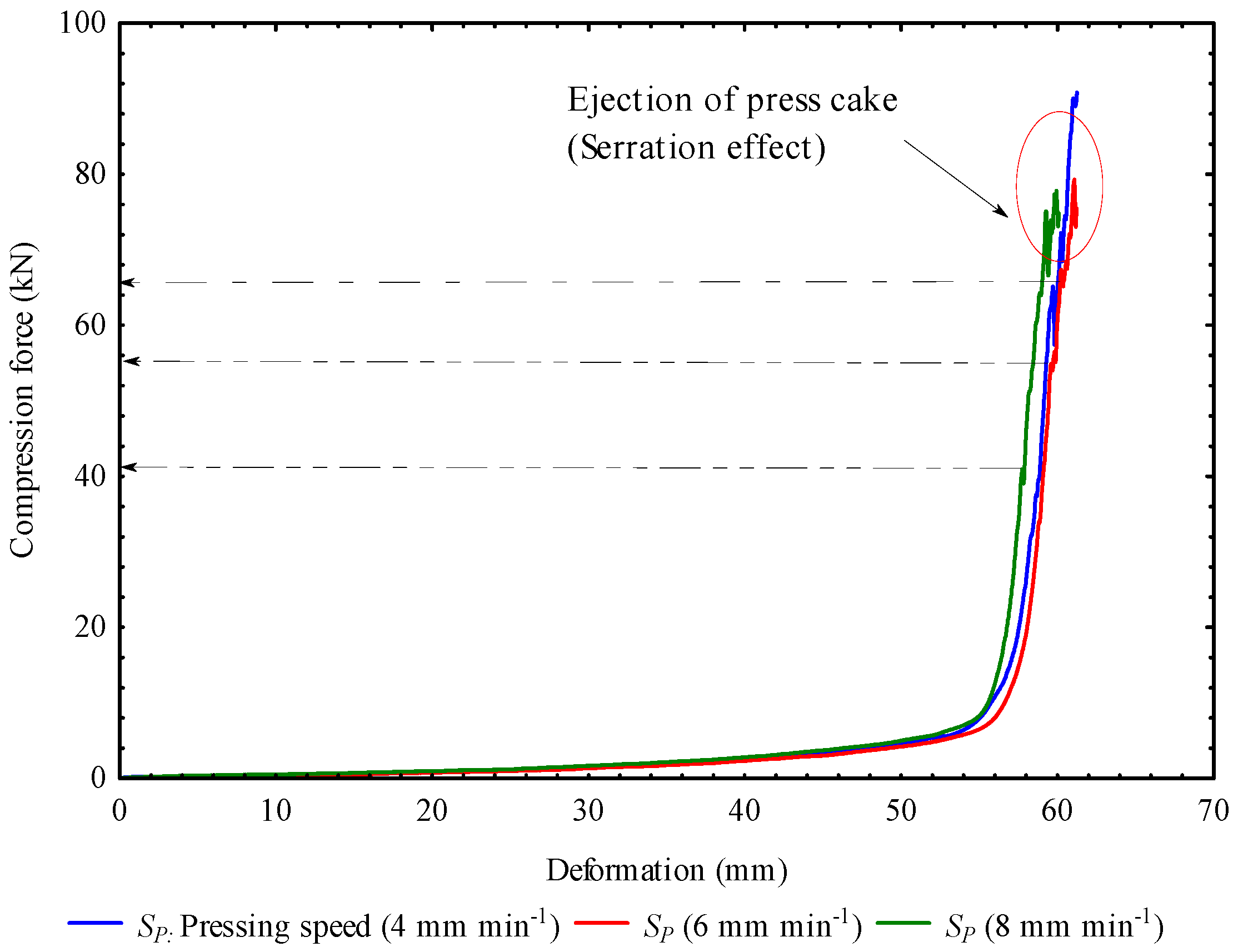
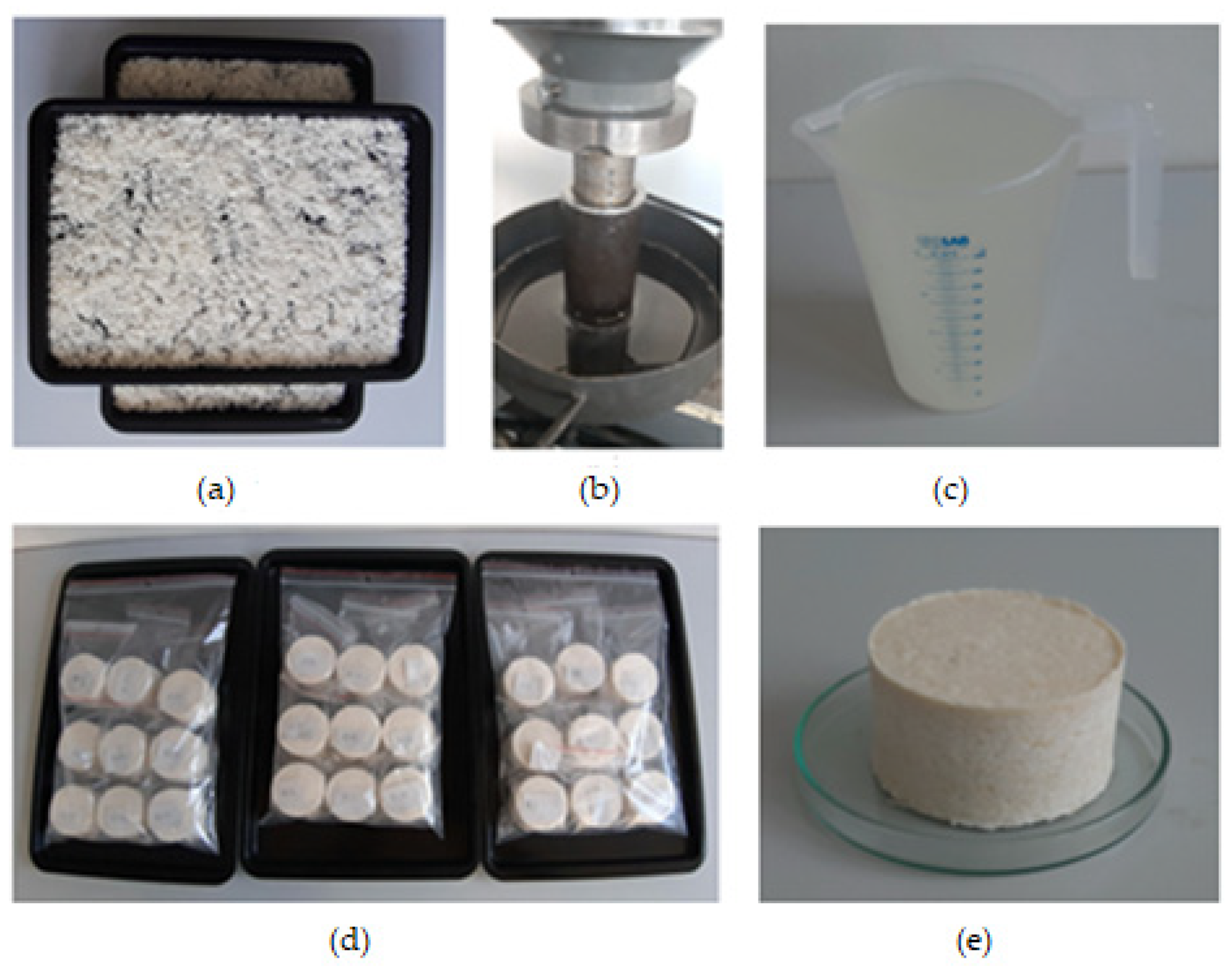

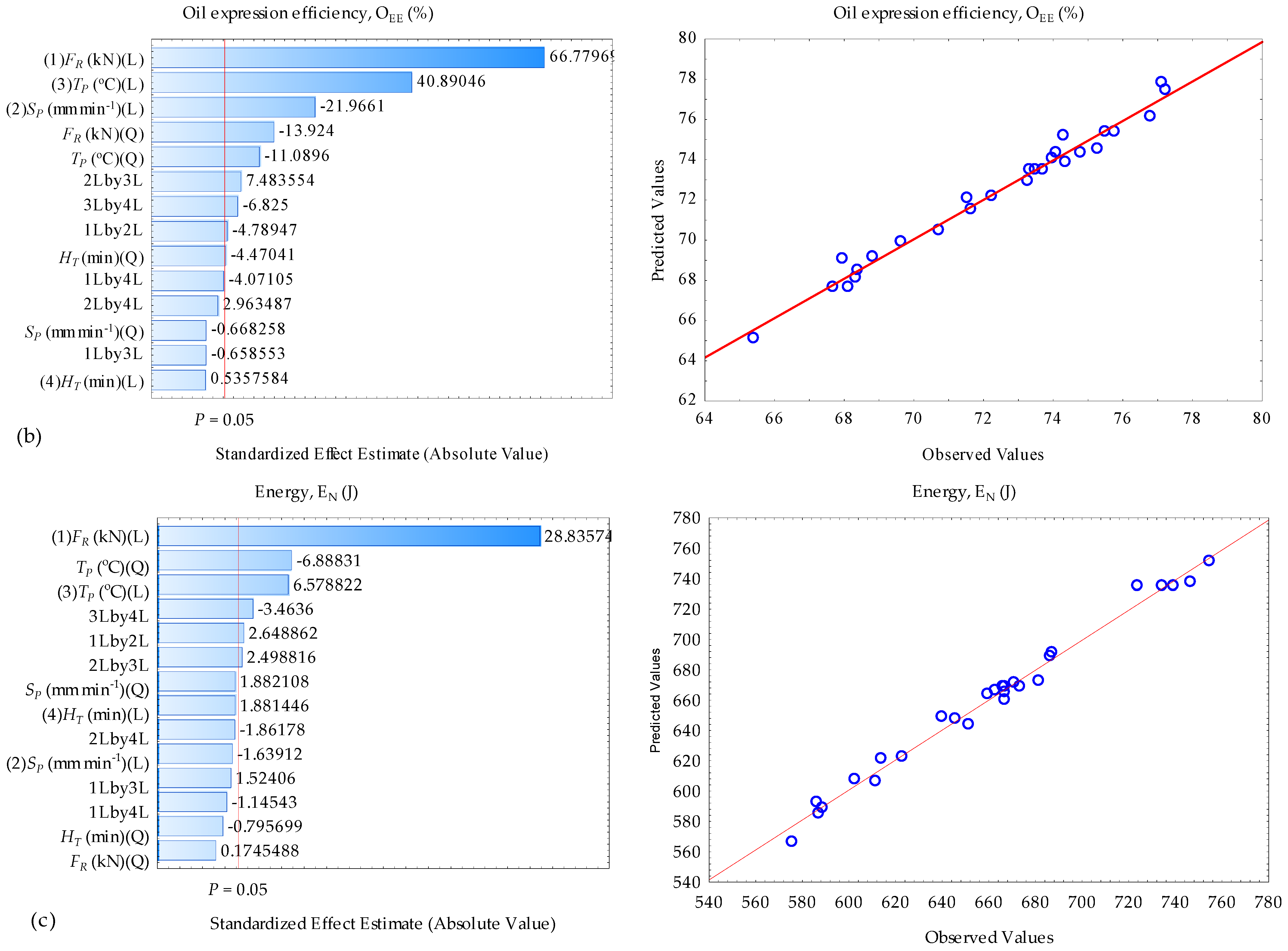
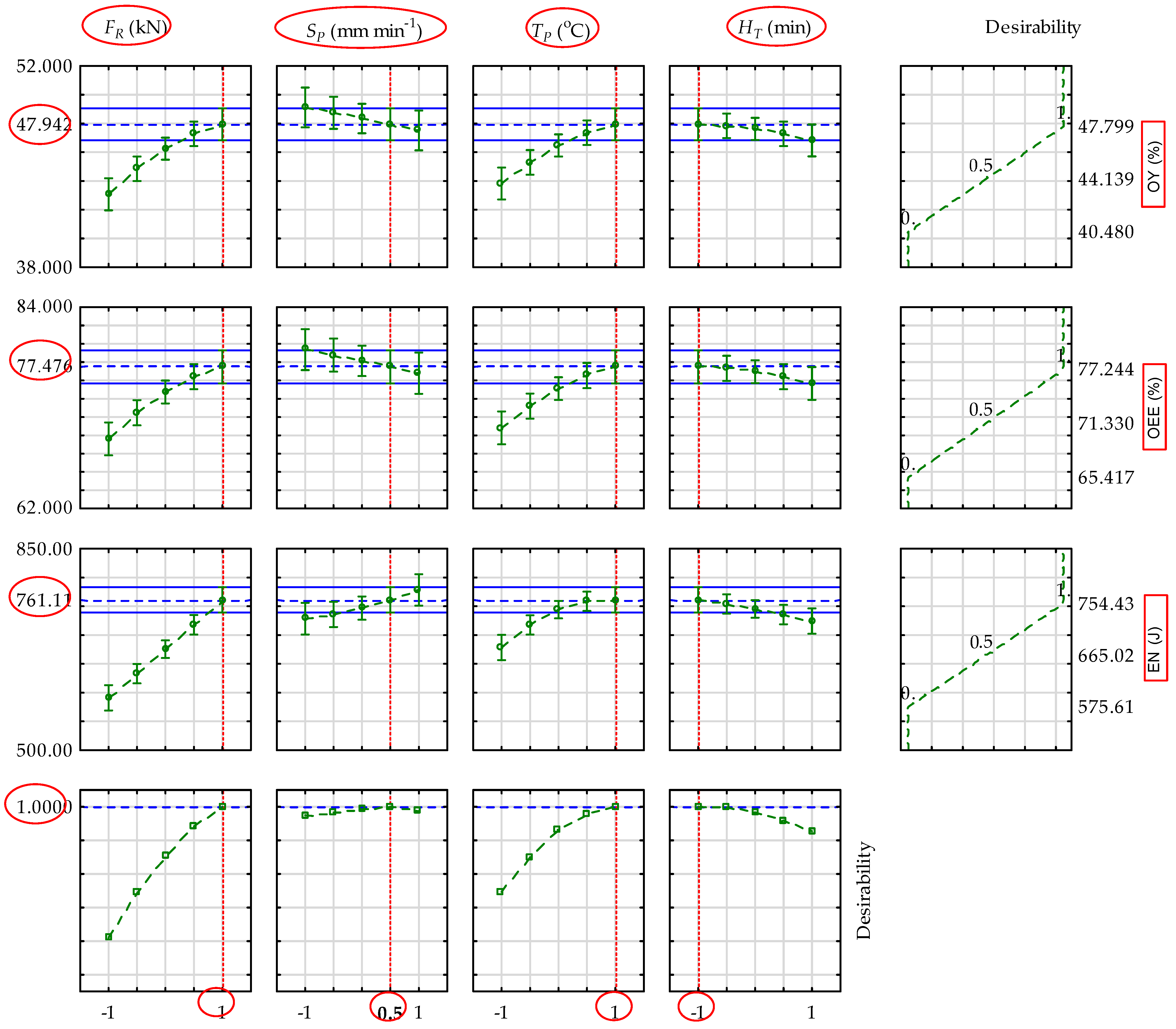
| Run | kN | , mm min−1 | , °C | , min | , g | , % | , % | , J | , mm | kN, mm−1 |
|---|---|---|---|---|---|---|---|---|---|---|
| 1 | 45 (−1) | 4 (−1) | 65 (0) | 45 (0) | 57.84 | 42.59 | 68.82 | 622.76 | 85.23 | 0.53 |
| 2 | 65 (1) | 4 (−1) | 65 (0) | 45 (0) | 64.83 | 47.73 | 77.14 | 746.83 | 88.09 | 0.74 |
| 3 | 45 (−1) | 8 (1) | 65 (0) | 45 (0) | 56.87 | 41.87 | 67.67 | 586.69 | 84.44 | 0.53 |
| 4 | 65 (1) | 8 (1) | 65 (0) | 45 (0) | 62.26 | 45.84 | 74.08 | 754.43 | 86.86 | 0.75 |
| 5 | 55 (0) | 6 (0) | 50 (−1) | 30 (−1) | 57.13 | 42.06 | 67.98 | 611.58 | 86.77 | 0.63 |
| 6 | 55 (0) | 6 (0) | 80 (1) | 30 (−1) | 62.45 | 45.98 | 74.31 | 662.98 | 87.22 | 0.63 |
| 7 | 55 (0) | 6 (0) | 50 (−1) | 60 (1) | 59.45 | 43.77 | 70.74 | 651.39 | 87.45 | 0.63 |
| 8 | 55 (0) | 6 (0) | 80 (1) | 60 (1) | 62.49 | 46.01 | 74.35 | 645.71 | 89.41 | 0.62 |
| 9 | 55 (0) | 6 (0) | 65 (0) | 45 (0) | 61.96 | 45.62 | 73.72 | 673.13 | 84.94 | 0.65 |
| 10 | 45 (−1) | 6 (0) | 65 (0) | 30 (−1) | 57.25 | 42.15 | 68.12 | 588.56 | 85.53 | 0.53 |
| 11 | 65 (1) | 6 (0) | 65 (0) | 30 (−1) | 64.56 | 47.53 | 76.82 | 739.65 | 86.89 | 0.75 |
| 12 | 45 (−1) | 6 (0) | 65 (0) | 60 (1) | 57.5 | 42.34 | 68.42 | 602.31 | 87.18 | 0.52 |
| 13 | 65 (1) | 6 (0) | 65 (0) | 60 (1) | 63.45 | 46.72 | 75.49 | 734.52 | 91.1 | 0.71 |
| 14 | 55 (0) | 4 (−1) | 50 (−1) | 45 (0) | 60.71 | 44.70 | 72.23 | 640.00 | 87.47 | 0.63 |
| 15 | 55 (0) | 8 (1) | 50 (−1) | 45 (0) | 57.42 | 42.28 | 68.32 | 613.96 | 84.99 | 0.65 |
| 16 | 55 (0) | 4 (−1) | 80 (1) | 45 (0) | 63.67 | 46.88 | 75.76 | 666.67 | 88.86 | 0.62 |
| 17 | 55 (0) | 8 (1) | 80 (1) | 45 (0) | 62.88 | 46.30 | 74.82 | 681.82 | 86.76 | 0.63 |
| 18 | 55 (0) | 6 (0) | 65 (0) | 45 (0) | 61.63 | 45.38 | 73.33 | 666.10 | 89.5 | 0.61 |
| 19 | 45 (−1) | 6 (0) | 50 (−1) | 45 (0) | 54.98 | 40.48 | 65.42 | 575.61 | 87.33 | 0.52 |
| 20 | 65 (1) | 6 (0) | 50 (−1) | 45 (0) | 61.59 | 45.35 | 73.28 | 687.13 | 89.46 | 0.73 |
| 21 | 45 (−1) | 6 (0) | 80 (1) | 45 (0) | 58.53 | 43.09 | 69.64 | 586.85 | 89.75 | 0.50 |
| 22 | 65 (1) | 6 (0) | 80 (1) | 45 (0) | 64.92 | 47.80 | 77.24 | 723.49 | 88.48 | 0.73 |
| 23 | 55 (0) | 4 (−1) | 65 (0) | 30 (−1) | 63.26 | 46.58 | 75.27 | 659.65 | 89.39 | 0.62 |
| 24 | 55 (0) | 8 (1) | 65 (0) | 30 (−1) | 60.22 | 44.34 | 71.65 | 671.28 | 84.6 | 0.65 |
| 25 | 55 (0) | 4 (−1) | 65 (0) | 60 (1) | 62.17 | 45.77 | 73.97 | 686.28 | 89.5 | 0.61 |
| 26 | 55 (0) | 8 (1) | 65 (0) | 60 (1) | 60.12 | 44.26 | 71.53 | 667.21 | 87.1 | 0.63 |
| 27 | 55 (0) | 6 (0) | 65 (0) | 45 (0) | 61.75 | 45.46 | 73.47 | 666.81 | 90.1 | 0.61 |
| Effect | Model (%) a | Std. Err. Pure Err. | Sum of Squares | df | Mean Square | F-Value | p-Value |
|---|---|---|---|---|---|---|---|
| Intercept | 45.49 | 0.07 | 106.54 | 14 | 7.61 | 43.79 | 0.00 * |
| 2.37 | 0.04 | 67.45 | 1 | 67.45 | 4459.53 | 0.00 * | |
| –0.74 | 0.05 | 2.93 | 1 | 2.93 | 193.88 | 0.01 * | |
| –0.78 | 0.04 | 7.30 | 1 | 7.30 | 482.51 | 0.00 * | |
| –0.04 | 0.05 | 0.01 | 1 | 0.01 | 0.45 | 0.57 ** | |
| 1.45 | 0.04 | 25.29 | 1 | 25.29 | 1672.03 | 0.00 * | |
| –0.59 | 0.05 | 1.86 | 1 | 1.86 | 122.98 | 0.01 * | |
| 0.02 | 0.04 | 0.00 | 1 | 0.00 | 0.29 | 0.65 ** | |
| –0.24 | 0.05 | 0.30 | 1 | 0.30 | 19.98 | 0.05 * | |
| * | –0.29 | 0.06 | 0.35 | 1 | 0.35 | 22.94 | 0.04 * |
| * | –0.04 | 0.06 | 0.01 | 1 | 0.01 | 0.43 | 0.58 ** |
| * | –0.25 | 0.06 | 0.25 | 1 | 0.25 | 16.57 | 0.06 ** |
| * | 0.46 | 0.06 | 0.85 | 1 | 0.85 | 56.00 | 0.02 * |
| * | 0.18 | 0.06 | 0.13 | 1 | 0.13 | 8.78 | 0.10 ** |
| * | –0.42 | 0.06 | 0.70 | 1 | 0.70 | 46.58 | 0.02 * |
| Residual | 2.08 | 12 | 0.17 | ||||
| Lack of fit | 2.05 | 10 | 0.21 | 13.59 | 0.07 ** | ||
| Pure Error | 0.03 | 2 | 0.04 | ||||
| Total | 108.63 | 26 |
| Effect | Model (%) b | Std. Err. Pure Err. | Sum of Squares | df | Mean Square | F-Value | p-Value |
|---|---|---|---|---|---|---|---|
| Intercept | 73.51 | 0.11 | 278.24 | 14 | 19.87 | 43.79 | 0.00 * |
| 3.83 | 0.06 | 176.14 | 1 | 176.14 | 4459.53 | 0.00 * | |
| −1.20 | 0.09 | 7.66 | 1 | 7.66 | 193.88 | 0.01 * | |
| −1.26 | 0.06 | 19.06 | 1 | 19.06 | 482.51 | 0.00 * | |
| −0.06 | 0.09 | 0.02 | 1 | 0.02 | 0.45 | 0.57 ** | |
| 2.35 | 0.06 | 66.04 | 1 | 66.04 | 1672.03 | 0.00 * | |
| −0.95 | 0.09 | 4.86 | 1 | 4.86 | 122.98 | 0.01 * | |
| 0.03 | 0.06 | 0.01 | 1 | 0.01 | 0.29 | 0.65 ** | |
| −0.38 | 0.09 | 0.79 | 1 | 0.79 | 19.98 | 0.05 * | |
| * | −0.48 | 0.10 | 0.91 | 1 | 0.91 | 22.94 | 0.04 * |
| * | −0.07 | 0.10 | 0.02 | 1 | 0.02 | 0.43 | 0.58 ** |
| * | −0.40 | 0.10 | 0.65 | 1 | 0.65 | 16.57 | 0.06 ** |
| * | 0.74 | 0.10 | 2.21 | 1 | 2.21 | 56.00 | 0.02 * |
| * | 0.29 | 0.10 | 0.35 | 1 | 0.35 | 8.78 | 0.10 ** |
| * | −0.68 | 0.10 | 1.84 | 1 | 1.84 | 46.58 | 0.02 * |
| Residual | 5.45 | 12 | 0.45 | ||||
| Lack of fit | 5.37 | 10 | 0.54 | 13.59 | 0.07 ** | ||
| Pure Error | 0.08 | 2 | 0.04 | ||||
| Total | 283.68 | 26 |
| Effect | Model (%) c | Std. Err. Pure Err. | Sum of Squares | df | Mean Square | F-Value | p-Value |
|---|---|---|---|---|---|---|---|
| Intercept | 668.68 | 2.23 | 66,768.48 | 14 | 4769.18 | 70.21 | 0.00 * |
| 68.61 | 1.12 | 56,482.09 | 1 | 56,482.09 | 3774.583 | 0.00 * | |
| 0.62 | 1.68 | 2.07 | 1 | 2.07 | 0.138 | 0.01 ** | |
| −3.90 | 1.12 | 182.50 | 1 | 182.50 | 12.196 | 0.00 ** | |
| 6.72 | 1.68 | 240.62 | 1 | 240.62 | 16.080 | 0.57 ** | |
| 15.65 | 1.12 | 2939.98 | 1 | 2939.98 | 196.473 | 0.00 * | |
| −24.58 | 1.68 | 3223.10 | 1 | 3223.10 | 215.393 | 0.01 * | |
| 4.48 | 1.12 | 240.45 | 1 | 240.45 | 16.069 | 0.65 ** | |
| −2.84 | 1.68 | 43.01 | 1 | 43.01 | 2.874 | 0.05 ** | |
| * | 10.92 | 1.93 | 476.61 | 1 | 476.61 | 31.851 | 0.04 * |
| * | 6.28 | 1.93 | 157.78 | 1 | 157.78 | 10.544 | 0.58 ** |
| * | −4.72 | 1.93 | 89.12 | 1 | 89.12 | 5.956 | 0.06 ** |
| * | 10.30 | 1.93 | 424.15 | 1 | 424.15 | 28.345 | 0.02 * |
| * | −7.67 | 1.93 | 235.45 | 1 | 235.45 | 15.735 | 0.10 ** |
| * | −14.27 | 1.93 | 814.90 | 1 | 814.90 | 54.458 | 0.02 * |
| Residual | 815.14 | 12 | 67.93 | ||||
| Lack of fit | 785.21 | 10 | 78.52 | 5.25 | 0.17 ** | ||
| Pure Error | 29.93 | 2 | 14.96 | ||||
| Total | 67,583.62 | 26 |
| Unit of Observed Responses | * Predicted Values (Equations (8)–(10)) | Experimental Values (Validated) | Percentage Error (%) |
|---|---|---|---|
| (%) | 48.48 | 48.18 ± 0.45 | 0.82 ± 0.65 |
| (%) | 78.35 | 77.86 ± 0.72 | 0.82 ± 0.65 |
| (J) | 749.58 | 731.36 ± 8.04 | 2.43 ± 1.07 |
Disclaimer/Publisher’s Note: The statements, opinions and data contained in all publications are solely those of the individual author(s) and contributor(s) and not of MDPI and/or the editor(s). MDPI and/or the editor(s) disclaim responsibility for any injury to people or property resulting from any ideas, methods, instructions or products referred to in the content. |
© 2024 by the authors. Licensee MDPI, Basel, Switzerland. This article is an open access article distributed under the terms and conditions of the Creative Commons Attribution (CC BY) license (https://creativecommons.org/licenses/by/4.0/).
Share and Cite
Kabutey, A.; Dajbych, O.; Sedláček, A.; Mizera, Č.; Herák, D. Application of the Surface Regression Technique for Enhancing the Input Factors and Responses for Processing Coconut Oil under Vertical Compression. Foods 2024, 13, 1384. https://doi.org/10.3390/foods13091384
Kabutey A, Dajbych O, Sedláček A, Mizera Č, Herák D. Application of the Surface Regression Technique for Enhancing the Input Factors and Responses for Processing Coconut Oil under Vertical Compression. Foods. 2024; 13(9):1384. https://doi.org/10.3390/foods13091384
Chicago/Turabian StyleKabutey, Abraham, Oldřich Dajbych, Aleš Sedláček, Čestmír Mizera, and David Herák. 2024. "Application of the Surface Regression Technique for Enhancing the Input Factors and Responses for Processing Coconut Oil under Vertical Compression" Foods 13, no. 9: 1384. https://doi.org/10.3390/foods13091384
APA StyleKabutey, A., Dajbych, O., Sedláček, A., Mizera, Č., & Herák, D. (2024). Application of the Surface Regression Technique for Enhancing the Input Factors and Responses for Processing Coconut Oil under Vertical Compression. Foods, 13(9), 1384. https://doi.org/10.3390/foods13091384







